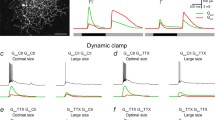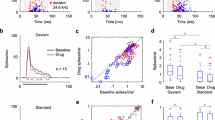Summary
1. Threshold-latency curves were determined by intracellular application of linearly rising currents to cat pyramidal tract (PT) cells under various conditions of impalement. The nature of the curves was found to vary considerably, depending mainly upon the resting potential level. Three different types of curves were distinguished: (1) the ceiling type at relatively high resting potentials, (2) the simple type at moderate levels and (3) the minimal gradient type under depolarized conditions. In the first type, the ceiling increased with increasing membrane potential level. The second type attained an extremely low ceiling. 2. After eliminating the effects of the resting potential, a significant difference was still found between the ceilings of fast and slow PT cells, the ceilings being higher in the former than in the latter. 3. Parameters determining the threshold-latency curve were analyzed by applying current steps intracellularly, as described in previous paper. The variations of the ceiling due to the resting potential level were found to be dominated by the first exponential component of the membrane, while those between fast and slow cells were ascribable to the second exponential component.
Similar content being viewed by others
References
Baker, P.F., A.L. Hodgkin and H. Meves: The effect of diluting the internal solution on the electrical properties of a perfused giant axon. J. Physiol. (Lond.) 170, 541–560 (1964).
Bradley, K., and G.G. Somjen: Accommodation of motoneurones of the rat and the cat. J. Physiol. (Lond.) 156, 75–92 (1961).
Chandler, W.K., A.L. Hodgkin and H. Meves: The effect of changing the internal solution on sodium inactivation and related phenomena in giant axons. J. Physiol. (Lond.) 180, 821–836 (1965).
Coombs, J.S., D.R. Curtis and J.C. Eccles: The interpretation of spike potentials of motoneurones. J. Physiol. (Lond.) 139, 198–231 (1957).
Eccles, J.C.: The Physiology of Synapses. Berlin-Göttingen-Heidelberg: Springer 1964.
Frankenhaeuser, B., and Å.B. Vallbo: Accommodation in myelinated nerve fibres of Xenopus Laevis as computed on the basis of voltage clamp data. Acta physiol. scand. 63, 1–20 (1965).
Hill, A.V.: Excitation and accommodation in nerve. Proc. roy. Soc. B 119, 305–355 (1936).
Hodgkin, A.L., and A.F. Huxley: A quantitative description of membrane current and its application to conductance and excitation in nerve. J. Physiol. (Lond.) 117, 500–544 (1952).
Ito, M., and T. Oshima: Electrical behavior of the motoneurone membrane during intracellularly applied current steps. J. Physiol. (Lond.) 180, 607–635 (1965).
Koike, H., Y. Okada, T. Oshima and K. Takahashi: Accommodative behavior of cat pyramidal tract cells investigated with intracellular injection of currents. Exp. Brain Res. 5, 173–188 (1968).
Moore, J.W., T. Narahashi and W. Ulbricht: Sodium conductance shift in an axon internally perfused with a sucrose and low-potassium solution. J. Physiol. (Lond.) 172, 163–173 (1964).
Narahashi, T.: Dependence of resting and action potentials on internal potassium in perfused squid giant axons. J. Physiol. (Lond.) 169, 91–115 (1963).
Sasaki, K., and H. Oka: Accommodation, local response and membrane potential in spinal motoneurons of the cat. Jap. J. Physiol. 13, 508–522 (1963).
—, and T. Otani: Accommodation in spinal motoneurons of the cat. Jap. J. Physiol. 11, 443–456 (1961).
— Accommodation in motoneurons as modified by circumstantial conditions. Jap. J. Physiol. 12, 353–369 (1962).
Sato, M.: Comparative measurements of accommodation in two nerve fibres of different sizes. Jap. J. Physiol. 1, 309–315 (1951).
Takahashi, K.: Slow and fast groups of pyramidal tract cells and their respective membrane properties. J. Neurophysiol. 28, 908–924 (1965).
—, K. Kubota and M. Uno: Recurrent facilitation in cat pyramidal tract cells. J. Neurophysiol. 30, 22–34 (1967).
Vallbo, Å.B.: Accommodation related to inactivation of the sodium permeability in single myelinated nerve fibres from Xenopus Laevis. Acta physiol. scand. 61, 429–444 (1964).
Author information
Authors and Affiliations
Rights and permissions
About this article
Cite this article
Koike, H., Okada, Y. & Oshima, T. Accommodative properties of fast and slow pyramidal tract cells and their modification by different levels of their membrane potential. Exp Brain Res 5, 189–201 (1968). https://doi.org/10.1007/BF00238663
Received:
Issue Date:
DOI: https://doi.org/10.1007/BF00238663




